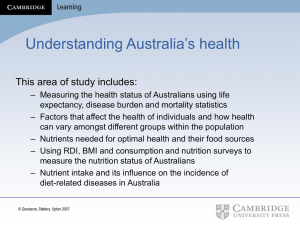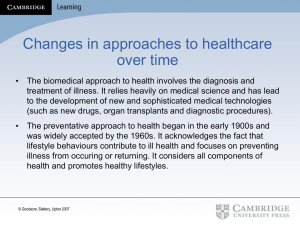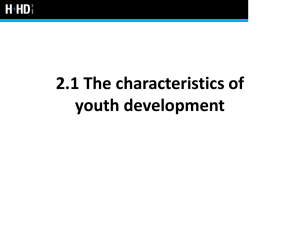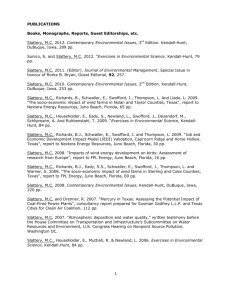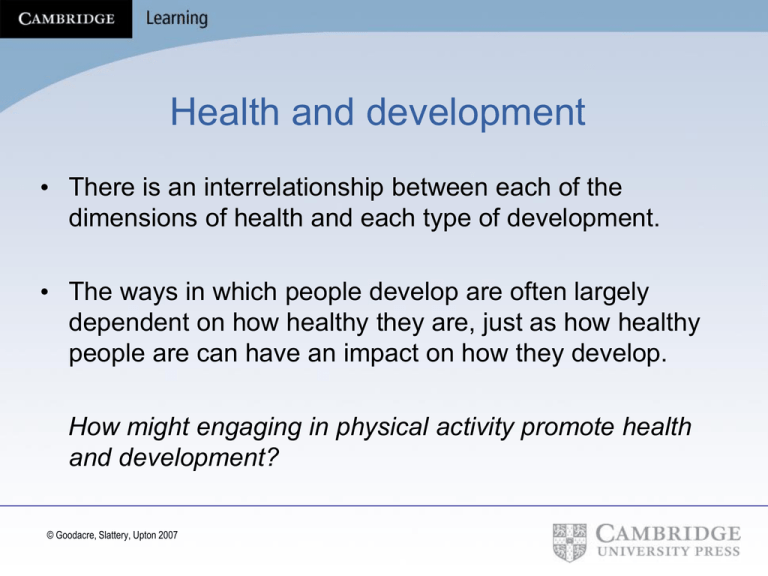
Health and development
• There is an interrelationship between each of the
dimensions of health and each type of development.
• The ways in which people develop are often largely
dependent on how healthy they are, just as how healthy
people are can have an impact on how they develop.
How might engaging in physical activity promote health
and development?
© Goodacre, Slattery, Upton 2007
Health
Development
Physical
Physical
Social
Social
Emotional
Emotional
Intellectual
What types of interactions are there between health and
development?
As a class, think of some examples.
© Goodacre, Slattery, Upton 2007
How about this?
• Play
– Physical: motor skills,
coordination
– Social: how to interact with
others
– Emotional: how to laugh, get
mad, smile
– Intellectual: learning rules,
procedures, new skills
© Goodacre, Slattery, Upton 2007
Even solitary play can assist with all
types of development. How?
Lifespan health and development
• Prenatal
– Approximately 40 weeks duration
– Germinal, embryonic, foetal stages
– Some key terms: what do they mean in the context of this stage?
conception
morulla
implantation
umbilical cord
placenta
fontanelles
blastocyst
differentiation
© Goodacre, Slattery, Upton 2007
Physical
– Germinal
– Embryonic
– Foetal
© Goodacre, Slattery, Upton 2007
What happens in each stage?
• Infancy
– Birth to 18 months
– Rapid growth and development
– Some key terms – what do they mean in the context of this stage?
fine motor skills
proximodistal
gross motor skills
bonding
socialisation
attachment
cephalocaudal
reflex
© Goodacre, Slattery, Upton 2007
• Physical
• Social
• Emotional
• Intellectual
© Goodacre, Slattery, Upton 2007
Give at least one example of
each type of development
experienced during this stage of
the lifespan.
• Childhood
– 3–12 years of age
– Slow, steady growth and development
– Some key terms – what do they mean in the context of this stage?
play
growth
socialisation
tooth development
learning
food ‘choices’
emotions
percentile
© Goodacre, Slattery, Upton 2007
• Physical
• Social
• Emotional
• Intellectual
© Goodacre, Slattery, Upton 2007
Give at least one example of
each type of development
experienced during this stage of
the lifespan.
• Adolescence
– 12–18 years of age
– Rapid growth and development
– Some key terms – what do they mean in the context of this stage?
ossification
hormones for growth
growth spurt
hormones for reproduction
puberty
socialisation
menarche
relationships
© Goodacre, Slattery, Upton 2007
• Physical
(male and female)
• Social
(male and female)
• Emotional
(male and female)
• Intellectual
(male and female)
© Goodacre, Slattery, Upton 2007
Give at least one example of
each type of development
experienced during this stage of
the lifespan.
• Adulthood
– 18 years of age and onwards
– Rapid growth and development
– Some key terms – what do they mean in the context of this stage?
career
socialisation
family
sensory acuity
relationships
menopause
education
retirement
© Goodacre, Slattery, Upton 2007
• Physical
(male and female)
• Social
(male and female)
• Emotional
(male and female)
• Intellectual
(male and female)
© Goodacre, Slattery, Upton 2007
Give at least one example of
each type of development
experienced during this stage of
the lifespan.
• Old age
– 65+ years of age
– Maintenance phase in relation to growth, but some types of
development still occurring
– Some key terms – what do they mean in the context of this stage?
maintenance
family
osteoporosis
socialisation
fractures
hobbies
falls
community resource
© Goodacre, Slattery, Upton 2007
• Physical
• Social
• Emotional
• Intellectual
© Goodacre, Slattery, Upton 2007
Give at least one example of
each type of development
experienced during this stage of
the lifespan.
Inherited influences on physical
development
• What are some examples of inherited influences
on physical development?
– Sex (gender)
• How? Examples?
– Genetic predisposition to disease?
• How? Examples?
– Hormonal control of the rate and timing of development
• How? Examples?
© Goodacre, Slattery, Upton 2007
Environmental influences on physical
development
• What are some examples of environmental influences
on physical development?
– Family
• How? Examples?
– Culture
• How? Examples?
– Socioeconomic Status (SES)
• How? Examples?
– Physical activity
• How? Examples?
– Access to healthcare
• How? Examples?
© Goodacre, Slattery, Upton 2007
The role of nutrition in optimising health
and development across the lifespan
• Nutrients are needed for:
–
–
–
–
Soft tissue
Hard tissue
Blood production
Energy production
Nutrients are needed particularly during the major ‘rapid
growth’ phases, but also at all other stages of the
lifespan.
© Goodacre, Slattery, Upton 2007
Nutrient Interactions
• Soft tissue
–
–
–
–
–
–
Protein
Vitamin C
Vitamin A
Vitamin E
Vitamin B12
Water
• Hard tissue
–
–
–
–
–
–
Calcium
Protein
Phosphorous
Magnesium
Vitamin D
Vitamin A
What specific function(s) to each of these nutrients have?
© Goodacre, Slattery, Upton 2007
• Blood production
–
–
–
–
–
–
–
Iron
Protein
Copper
Vitamin C
Vitamin E
Folate
Vitamin B12
• Energy production
–
–
–
–
CHO
Protein
Fats
B group vitamins
(thiamin, riboflavin, niacin, B6)
– Iron
– Iodine
What specific function(s) to each of these nutrients have?
© Goodacre, Slattery, Upton 2007
SOFT TISSUE
Vitamin E
Vitamin B12
Water
Vitamin A
Protein
HARD TISSUE
Calcium
Phosphorous
Magnesium
Vitamin D
Vitamin A
Vitamin C
Iron
ENERGY PRODUCTION
CHO
Fats
Iodine
© Goodacre, Slattery, Upton 2007
BLOOD FORMATION
Copper
Folate
Vitamin B12
Vitamin E

